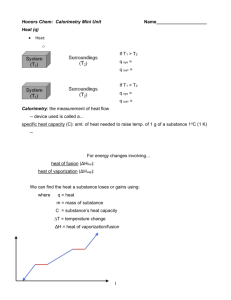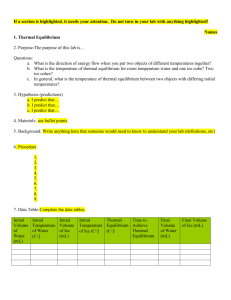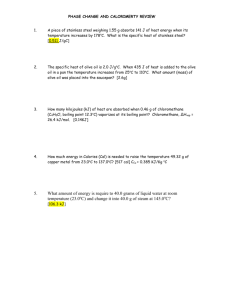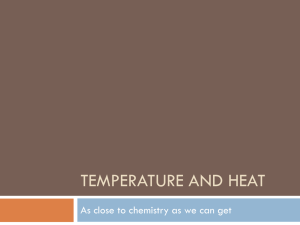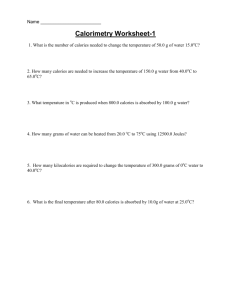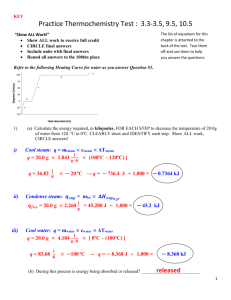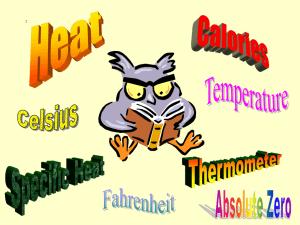Temp. & Heat
advertisement
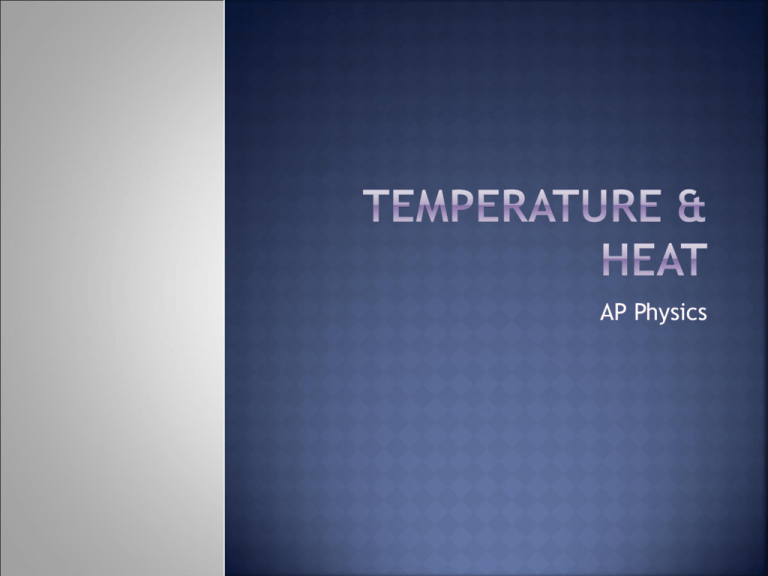
AP Physics A measure of the average kinetic energy of the particles in a sample of matter, expressed in terms of units or degrees designated on a standard scale ~American Heritage Dictionary 3 Scales Scale Fahrenheit Celsius Kelvin Boiling Point of H2O Freezing Point of H2O Absolute Zero Two systems are in thermal equilibrium if and only if they have the same temperature. Two systems that are each in thermal equilibrium with a third system are in thermal equilibrium with each other. Most materials expand when their temperature increases. Linear Expansion Expansion in one dimension (usually the length) change in length is proportional to the change in temperature Material α (1/oC) Aluminum 24 x 10-6 Brass & Bronze 19 x 10-6 Copper 17 x 10-6 Steel 11 x 10-6 Concrete 12 x 10-6 A steel railroad track has a length of 30.000 m when the temperature is 0oC. What is its length on a hot day when the temperature is 40oC? α = 11 x 10-6 (oC)-1 James Joule discovered by various means that he could heat a body of water by purely mechanical means: a) by lowering a weight and letting a paddle wheel stir the water b) by passing electric current through a resistor c) by compressing a piston immersed in the water d) by friction from rubbing blocks together. He found that about 800 foot-pounds ( 1 kilo joule) of work could raise the temperature of one pound (.45 kilograms) of water one Fahrenheit degree (0.55oC). Energy that is transferred from one object or system to another object or system as a result of a temperature difference. (The concept of heat only has meaning as energy in transit.) Heat flow is energy transfer. Units: Joule (J), calorie (cal), Calorie (Cal), British thermal unit (Btu) Unit Relations Joules calories Calories Btu 1 0.239 2.39 x 10-4 9.48 x 10-4 4.186 1 0.001 3.97 x 10-3 4186 1000 1 3.97 1055 252 0.252 1 The calorie is defined as the amount of heat required to raise the temperature of 1 gram of water from 14.5oC to 15.5oC. One Btu is defined as the quantity of heat required to raise the temperature of 1 pound of water from 63oF to 64oF. Quantity of heat needed to change the temperature of a system is dependent on three things: 1. The quantity of the temperature change. 2. The mass of the system. 3. The nature of the material. The amount of heat Q needed for a certain temperature change ΔT is proportional to the temperature change and to the mass m of substance being heated; During a bout with the flu, an 80 kg man ran a fever of 2.0 Co. His body temperature was 39.0oC (102.2oF) instead of the normal 37oC. Assuming that the human body is mostly water, how much heat was required to raise his temperature by that amount? Material c [J/(kg·K)] Water 4.19 x 103 Ice (-25oC to 0oC) 2.01 x 103 Aluminum 0.91 x 103 Salt 0.88 x 103 Iron 0.47 x 103 Silver 0.23 x 103 You are an electric engineer designing an electronic circuit element made of 23 mg of silicon. The electric current through it adds energy at the rate of 7.4 mW (7.4 x 10-3 J/s). If your design doesn’t allow for any heat transfer out of the element, at what rate does its temperature increase? The specific heat capacity of silicon is 705 J/(kg·K). Ingot - metal that is cast in the shape of a block for convenient handling A 0.0500 kg ingot of metal is heated to 200.0oC and then dropped into a beaker containing 0.400 kg of water that is initially at 20.0oC. If the final equilibrium temperature of the mixed system is 22.4oC, find the specific heat of the metal. Three familiar phases of matter include: 1. Gases 2. Liquids 3. Solids …but there are more than those three including… plasmas, superfluids, supersolids, Bose-Einstein condensates, fermionic condensates, liquid crystals, strange matter and quark-gluon plasmas Transition from one phase of matter to another What goes on during a phase change? At a given pressure, phase changes: 1. usually occur at a definite temperature* 2. heat is absorbed or released 3. there is a change in volume of the matter 4. there is a change in density of the matter *At this temperature and pressure both phases of matter can coexist, this is called phase equilibrium. Phase Change Process Solid Liquid Example Metal gallium melts in your hand Liquid Solid Water freezes Liquid Gas Liquid Nitrogen boils at room temp. Gas Liquid Solid Gas Gas Solid To melt a mass m of material that has a heat of fusion Lf requires a heat Q given by: Water vapor condenses Dry Ice (CO2) sublimes to its gaseous phase at room temp Frost forms on cold objects Heat Required per unit mass Latent Heat of Fusion (Lf) Latent Heat of Vaporization (Lv) Latent Heat of Sublimation (Ls) To freeze a mass m of material that has a heat of fusion Lf requires a heat Q given by: To cause a phase change energy must be absorbed or released by the object/system. During the phase change the heat energy does not change the temperature of the object. A physics student wants to cool 0.25 kg of Mountain Dew (mostly water and high fructose corn syrup) initially at 20oC by adding ice initially at -20oC. How much ice should she add so that the final temperature will be 0oC with all the ice melted? Assume that the heat capacity of the container may be neglected. There are three mechanisms of heat transfer. 1. Radiation 2. Convection 3. Conduction Energy transfer through electromagnetic radiation (fancy words for light) Ex. Energy transfer of heat by the motion of a mass of fluid Ex. heat transfer through a material from regions of higher temperatures to regions of lower temperatures Good thermal conductors are metals because they have many free electrons Ex. Rate of Heat Transfer…Heat Current (H) The rate of heat transfer through a material with regions of varying temperatures is: proportional to the cross sectional area A. proportional to the temperature difference ΔT. inversely proportional to the distance between the regions L. The constant of proportionality is the thermal conductivity of the material k. The StyrofoamTM box seen below is used to keep drinks cold at a picnic (or wild beach party whatever suits your taste). The total area of the sides, top, and bottom is 0.80 m2, and the wall thickness is 2.0 cm. The box is filled with ice and Root Beer, keeping the inner surface at 0oC. What is the rate of heat flow into the box if the temperature of the outside surface is 30oC? How much ice melts in one day (24 hr.)? Material k (W/(m·K) Silver 406 Copper 385 StyrofoamTM 0.01 Wood 0.12 – 0.04 Air 0.024 A steel bar 10.0 cm long is welded end to end to a copper bar 20.0 cm long. Each bar has a square cross section, 2.00 cm on a side. The free end of the steel bar is in contact with steam at 100oC, and the free end of the copper bar is in contact with ice at 0oC. Find the temperature at the junction of the two bars and the total rate of heat flow. Material k (W/(m·K) Steel 50.2 Copper 385
